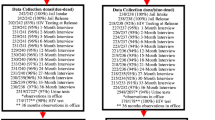Abstract
This study examines the role of family status and demographic characteristics in explaining the nearly 60% dropout rate for women in substance abuse treatment. Data from the administrative record files of the Illinois Office of Alcoholism and Substance Abuse (OASA) for the fiscal year 1996–97 were analyzed for women age 12 or older who completed intake for publicly funded substance abuse treatment and whose outpatient treatment records were closed at year-end. Multivariate logistic regression models found that the likelihood of not completing treatment was greatest for women who were African American, pregnant, had custody of minor children, or were younger than age 21. However, African American women who had children in foster care were more likely to complete treatment. Implications for treatment and research are discussed.
Similar content being viewed by others
References
Gomberg ESL: Gender issues. In: Galanter M. (Eds.):Recent Developments in Alcoholism, Volume II: Ten Years of Progress. New York: Plenum, 1993, pp. 95–107.
Blume SA: Alcohol and drug problems in women: Old attitudes, new knowledge. In Milkman HB, Sederer LI (Eds.):Treatment Choices for Alcoholism and Substance Abuse. Lexington, MA: Lexington Books, 1990, pp. 183–200.
Ingersoll KS, Lu IL, Haller DL: Predictors of in-treatment relapse in perinatal substance abusers and impact on treatment retention: A prospective study.Journal of Psychoactive Drugs 1995; 27(4):375–387.
Strantz IH, Welch SP: Postpartum women in outpatient drug abuse treatment: Correlates of retention/completion.Journal of Psychoactive Drugs 1995; 27(4):357–373.
Leigh G, Ogborne AC, Cleland P: Factors associated with patient dropout from an outpatient alcoholism treatment service.Journal of Studies on Alcohol 1984; 45:359–362.
Saunders B, Baily S, Philips M: Women with alcohol problems: Do they relapse for reasons different to their male counterparts?Addictions 1993; 88(10):1413–1422.
Chavkin W, Breitbart V: Substance abuse and maternity: The United States as a case study.Addiction 1997; 92(9):1201–1205.
Finkelstein N: Treatment programming for alcohol and drug-dependent pregnant women.International Journal of the Addictions 1993; 13:1275–1309.
Bell K, Cramer-Benjamin D, Anastas J: Predicting length of stay of substance-abusing pregnant and postpartum women in day treatment.Journal of Substance Abuse Treatment 1997; 14(4):393–400.
Grella CE: Women in residential drug treatment: Differences by program type and pregnancy.Journal of Health Care for the Poor and Underserved 1999; 10(2):216–229.
Woodside M: Policy issues and action: An agenda for children of substance abusers. In: Rivinus TM (Ed.):Children of Chemically Dependent Parents: Multiperspectives from the Cutting Edge. New York: Brunner/Mazel, 1991, pp. 330–345.
Dennis ML, Hristova L, Foss M.Special Runs on Illinois' Electronic DASA Automated Reporting and Tracking System (DARTS) Data Base on All Publicly Funded Treatment for 154,255 Patients Served (68,264 unique individuals) for Fiscal Year 1997 (7/9626/97). Bloomington, IL: Chestnut Health Systems, 1999. (Done under NIDA Grant R01 DA11977.)
Patient Placement Criteria for the Treatment of Substance-Related Disorders. Second ed. Chevy Chase, MD: American Society of Addiction Medicine (ASAM), 1996.
Frohna JG, Lantz PM, Pollack H. Maternal substance abuse and infant health: Policy options across the life course.Milbank Quarterly 1999; 77(4):531–570.
Howell EM, Heiser N, Harrington, M: A review of recent findings on substance abuse treatment for pregnant women.Journal of Substance Abuse Treatment 1998; 16(3):195–219.
Polinsky ML, Hser Y, Grella, CE: Consideration of special populations in the drug treatment system of a large metropolitan area.Journal of Behavioral Health Services & Research 1998; 25(1):7–21.
Copeland J, Hall W: A comparison of predictors of treatment drop-out of women seeking drug and alcohol treatment in a specialist women's and two traditional mixed-sex treatment services.British Journal of Addictions 1992; 87(6):883–890.
Thoma R: A critical look at foster care: How great the need? Online at http://home.rica.net/rthoma/foster02.htm. Last updated June 24, 1998; 1–12.
Messer K, Clark KA, Martin SL: Characteristics associated with pregnant women's utilization of substance abuse treatment services.American Journal of Drug and Alcohol Abuse 1996; 22(3):403–422.
Angeriou M, Daley M: An examination of racial and ethnic differences with a sample of Hispanic, white (non-Hispanic), and African American Medicaid-eligible pregnant substance abusers: The MOTHERS Project.Journal of Substance Abuse Treatment 1997; 14(5):489–498.
Brown TG, Kokin M, Seraganian P, et al.: The role of spouses of substance abusers in treatment: Gender differences.Journal of Psychoactive Drugs 1995; 27(3):223–229.
Robertson MJ: Homeless women with children: The role of alcohol and other drugs. American Psychologist 1991; 46(11):1198–1204.
Murray PM: Treating homeless people with alcohol and other drug problems: Issues for practice and evaluation.Journal of Mental Health Administration 1993; 20(2):87–89.
Farrow JA, Watts DH, Krohn MA, et al.: Pregnant adolescents in chemical dependency treatment.Journal of Substance Abuse 1999; 16(2):157–161.
Author information
Authors and Affiliations
Corresponding author
Rights and permissions
About this article
Cite this article
Scott-Lennox, J., Rose, R., Bohlig, A. et al. The impact of women's family status on completion of substance abuse treatment. The Journal of Behavioral Health Services & Research 27, 366–379 (2000). https://doi.org/10.1007/BF02287819
Issue Date:
DOI: https://doi.org/10.1007/BF02287819




